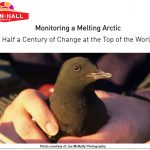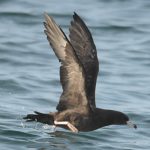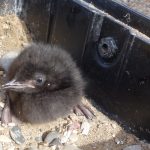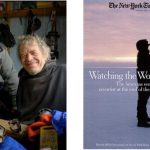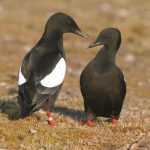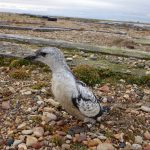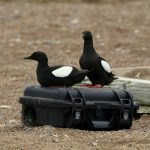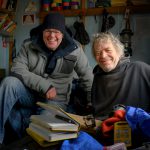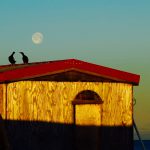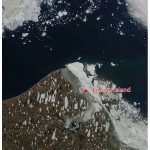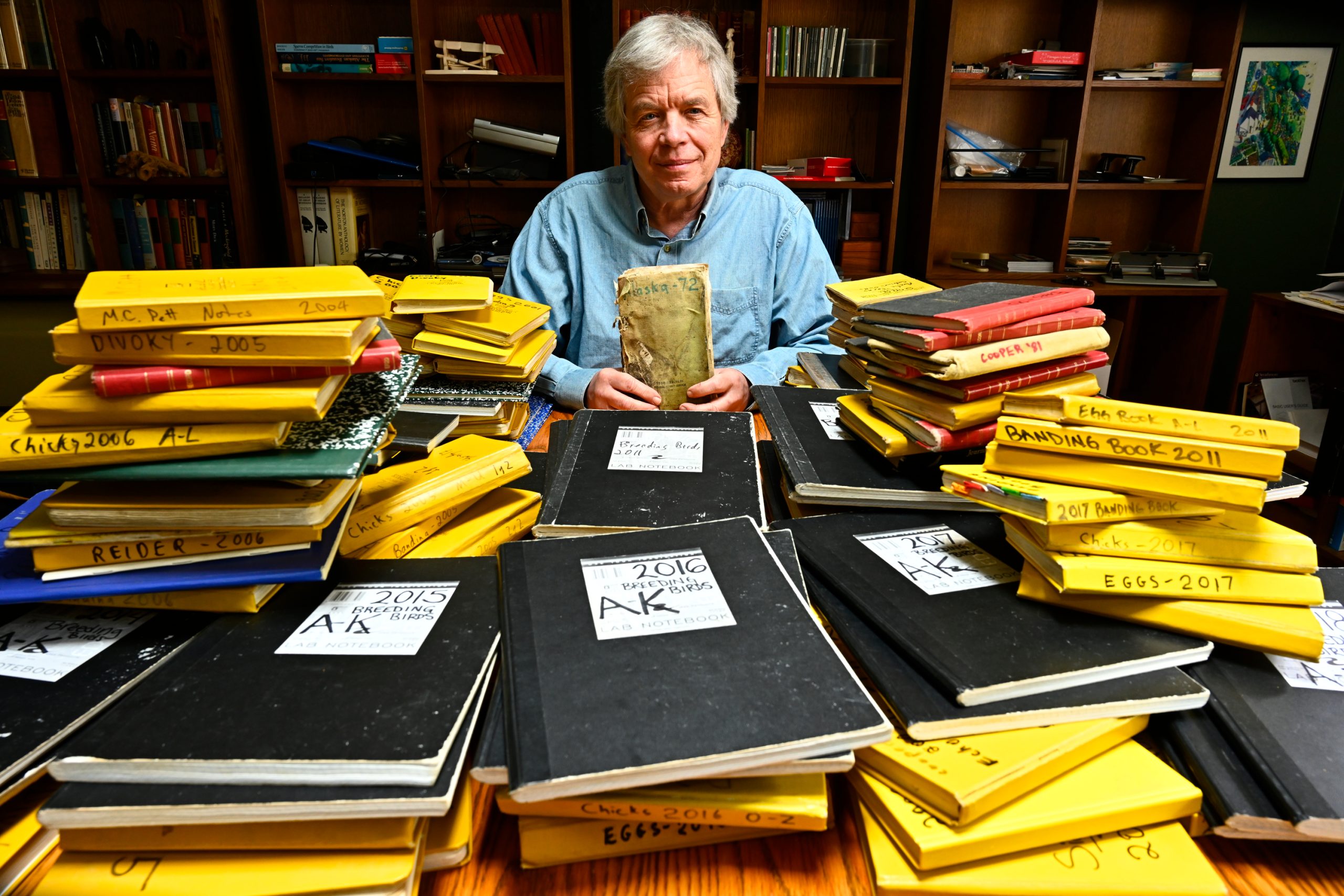
Field Notes
2021 Field Season
2021 Field Season
- 2022 Cooper Island Update
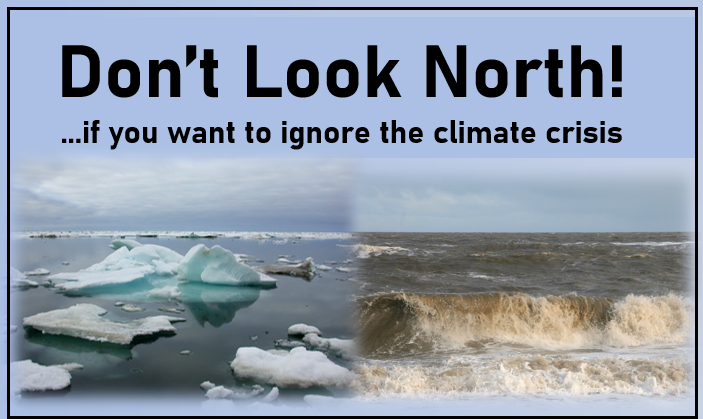 March 15, 2022 Town Hall Seattle Reception at 6 pm with presentation at 7 pm We are happy to once again have an in-person event in Seattle at Town Hall Seattle, but glad the presentation will also be available on YouTube for live streaming and later viewing on our YouTube channel. The evening will begin with an in-person reception starting at 6 pm and we look forward to sharing light fare, beverages and conversation with old and new friends. The in-person and virtual presentation starting at 7 pm will include an overview of George Divoky’s half-century on Cooper Island documenting…
March 15, 2022 Town Hall Seattle Reception at 6 pm with presentation at 7 pm We are happy to once again have an in-person event in Seattle at Town Hall Seattle, but glad the presentation will also be available on YouTube for live streaming and later viewing on our YouTube channel. The evening will begin with an in-person reception starting at 6 pm and we look forward to sharing light fare, beverages and conversation with old and new friends. The in-person and virtual presentation starting at 7 pm will include an overview of George Divoky’s half-century on Cooper Island documenting…
2020 Field Season
- View video of our February 2021 UpdateDr. George Divoky’s long-term study of Arctic seabirds has dramatically documented global warming and its consequences on the Black Guillemot colony.
- The nearly impossible 2020 field seasonMaintaining a long-term study of an Arctic seabird on a remote island off the northern Alaska coast has never been easy. Maintaining that study in 2020, when very few things anywhere in the world were easy, meant dealing with a new set of logistical hurdles and personal dilemmas and sacrifices. Thanks to the extraordinary help of extraordinary friends, however, in this year of such disruption for all of us I am happy to report that, against all odds, we were able to collect data for the 46th straight year on Cooper Island this summer. During March and April, when I…
- Red-legged guillemots and a problematic shearwaterOn first sight, what most people notice about Black Guillemots in their summer plumage are their bright red legs. The species could easily be called “Red-legged Guillemot” – were there not two other species in the guillemot genus Cepphus with red legs.
- A decreased breeding effort, but the colony persists.This improbable 2020 field season is finishing its second week. As I anticipated, being back in Utqiagvik and heading out to Cooper Island helped make this bizarre year feel a little more normal. But once on the island, my initial census of the colony quickly reminded me that, while the entire world is focused on the disruptions and dangers of the pandemic, the repercussions of a melting Arctic continue – as they have for the majority of the 47-year Cooper Island study. In the late 1980s the Mandt’s Black Guillemot colony on Cooper Island had over 200 breeding pairs, thanks…
- Against all odds: a 2020 field seasonIn early spring, when the first evidence of the scale of the pandemic was becoming clear, many field biologists realized that restrictions or concerns about travel would prevent them from having a field season. The impact was especially bad for graduate students and early career researchers who had worked hard to obtain funding and prepare for the 2020 field season. It also was a major blow to those of us who have conducted continuous long-term studies requiring annual field work. Friends of Cooper Island was impacted by the earliest stages of the pandemic when we had to cancel our annual…
2019 Field Season
- [POSTPONED] Annual Seattle Update – Tuesday March 17thWatching the Arctic Melt Away We regretfully have to postpone our annual Seattle update due to increasing concerns about the COVID-19 coronavirus and our patrons’ health, including the recent decision by Town Hall Seattle to suspend in-person attendance for all events. Reporting to our followers at our Seattle annual event is a yearly highlight for George. This is also Friends of Cooper Island’s main fundraising event for the year, with paying for the venue a major expenditure. We are postponing (rather than cancelling) in part to save some of our Town Hall rental, as well as to be able to…
- A Visit From a French DemographerThanks to our participation in the international Sentinels of Sea Ice (SENSEI) project, this summer the Cooper Island field camp was visited by Pierre-Loup Jan, the post-doc analyzing the Cooper Island demographic data set. After 44 years of sharing the island with a seabird with a French name (“guillemot” is the diminutive of Guillaume – the French version of “William) it was fitting to have a French researcher on the island with me. We are very fortunate to have Pierre-Loup and his colleagues in France collaborating with us. He was a welcome addition to the 2019 field camp as he…
- The Darkness of Augustby George Divoky While much has changed over the course of the 45 summers I have spent on Cooper Island, as warming from anthropogenic carbon emissions has modified the Arctic’s snow and ice habitats, one thing has remained constant. The sun is always above the horizon for 24 hours when I arrive in early June and it does not set until precisely August 2. The importance and impact of that constant daylight is hard to overstate. When I arrive on the island I am not constrained by the day-night/light-dark cycle that I just left in Seattle, and I can work on whatever…
- Loss of Sea Ice Takes Its Toll on SeabirdsBy George Divoky The positive signs of colony size and breeding effort of the Black Guillemots on Cooper Island in June were too good to last. After very high hatching success, the decreased ice and increased water temperatures took their toll as parents were unable to find prey in the warm, ice-free waters. Rapidly shifting ocean temperatures provided some days of good growth, but currently only one third of chicks are still alive. As the mortality was unfolding, we shared it with a reporter from the Washington Post for an article describing the impacts of climate change in Alaska in…
- Birds on Nests During IncubationBy George Divoky The Black Guillemots on Cooper Island continued to show signs of a turnaround from the poor breeding season of 2018 as egg laying and incubations has occurred in over 75 nests this year, compared to only 25 last year. The breeding population saw the recruitment of 20 birds that had fledged from the island in past years but had yet to breed. This is important since it shows that even with the decreased reproductive success and poor ice conditions of recent years, some birds are surviving to breeding age (typically 3-years of age) and returning to their natal colony,…
- A visit from a long-term friend of Cooper IslandBy George Divoky Cooper Island has provided me with a place to conduct a long-term study of an Arctic seabird and also a place where I have been fortunate to establish some long-term friendships. In June 2001, photographer Joe McNally visited the island to obtain images to accompany the New York Times story Darcy Frey was writing about the Cooper Island research. Joe’s week on the island in 2001 started with him being sick in his tent for the first two days but, after he and I had spent a week walking through the guillemot colony and chatting back at camp, ended…
- Field Season Update: 75 active nest sitesPolar bears caused me to get a cabin on Cooper Island in 2003. After a rapid retreat of sea ice in August 2002, bears trashed our tents, which required making a hasty departure from the island with the help of a North Slope Borough Search and Rescue helicopter. The first week of the 2019 field season found me again living in a tent as I cleaned up after a polar bear was able to remove the board covering the cabin door and rearrange much of the gear and supplies I store on the island overwinter. Damage was not major but making my…
- Start of the 45th field seasonEven after 44 years, preparing for the field season to study Black Guillemots on Cooper Island is a time of excitement and anticipation as I gather the gear and supplies needed to survive and conduct research for three months on a remote Arctic island. This year the excitement was tempered with a high level of anxiety given last summer’s disastrous breeding season. While the size of the colony has been decreasing since the 1990s, as the guillemots’ sea ice habitat has steadily dwindled, the 2018 breeding season was unique in that 1) the overwinter mortality of breeding birds was three…
2018 Field Season
- 2019 Seattle Update – March 26Tuesday March 26 at Seattle’s Swedish Club Reception at 6 pm with presentation at 7 pm Reception at 6 pm with talk at 7 pm The Cooper Island Black Guillemot colony was first recognized as a monitor of a warming climate in 2002, the 23rd year of the study. Decreasing sea ice in a rapidly melting Arctic continues to diminish its population and breeding success. Now in its 44th year, and with evidence of global climate change increasingly evident, our research is documenting this Arctic seabird’s struggle to survive. Join us to hear about the current status of this unique Arctic seabird – our canary in…
- 44th Cooper Island field season comes to an endEnd of season field report by George Divoky. For the past four decades, my field seasons on Cooper Island studying Black Guillemots have always begun with high spirits and a feeling of optimism. Experiencing the 24 hours of daylight in early June while documenting the return of individual birds to the island and their nest sites is always uplifting – some of these seabirds have been returning to Cooper Island for decades. Then, the days begin to shorten as nighttime returns to the Arctic. After monitoring the colony’s breeding activity for over three months, the end of the field season…
- The first chick of 2018 has fledged from Cooper Island!In a breeding season and field season that has been a tough one for both the Black Guillemots on Cooper Island and the investigators studying them, today was a day of celebration as morning nest checks revealed that the oldest nestling on the island had departed for the sea during the night. The first fledge of the year is always exciting since it is an important benchmark in our field season, which begins with recording the owners of nest sites and continues with observing the dates of egg laying and monitoring the hatching and subsequent growth of nestlings. While it…
- Uncertain Future for Nestlings: Sea ice retreat shifts prey out of foraging rangeGeorge’s latest field report describes his daily nest checks as parents are feeding chicks to prepare them for fledging. Black Guillemots have their young remain in the nest for almost five weeks, being nearly adult weight and independent of the parents when fledging. Returning to the nest with a single fish in their bill is a breeding strategy found in all member of the genus Cepphus; it reflects the abundance and predictability of prey in the nearshore waters where parents forage while provisioning young. For guillemots breeding in subarctic and temperate areas, where the nearshore provides a diverse and ample supply…
- Long-term Data Collection Serves Many: Cooper Island study aids graduate students studying climate changeGraduate student Drew Sauve recently returned from Cooper Island. He describes his collaboration with George in this guest post. The Black Guillemots on Cooper Island are one of many wild populations that are responding to climate change by changing when they lay their eggs. These Arctic seabirds want to lay their eggs as soon as the winter snow melts and spring begins, because their breeding season—from first access to a nest cavity to departure of chicks—is 80 days, an exceptionally long breeding period for a bird. Parent guillemots have to have their young ready to fly off to sea before…
- Hatched! So far, so good for the 2018 chicks on Cooper IslandAugust 11, 2018: Field report Hatching is finally over with one very late egg hatching today after having been incubated for 34 days; 28 days is normal. The oldest nestling is 16 days old; the chick is gaining weight and doing well like all of the other 45 nestlings. While the main pack ice is well offshore, the Marginal Ice Zone, where ice covers from 18 to 80 percent of the ocean’s surface, extends south to the entire Alaskan Beaufort Sea coast, including Cooper Island. The seascape visible from the north beach now has widely scattered floes, some with rather…
- First chicks of the 2018 seasonAugust is the rainy month of our field season, and the first day of the month was tough for us. During our morning nest checks, it wasn’t easy to keep our hands warm in a steady soaking rain, coupled with a windchill of 27 degrees Fahrenheit. The fingerless gloves I wear daily in the summer are a godsend for handling eggs and nestlings–wet fingerless gloves at temperatures near freezing are only slightly better than no gloves at all. The cold, wind and rain (and numb fingers) were made more bearable by the fact that our nest checks found hatching high…
- 2018 CensusIn this week’s field report, George talks about specific birds as well as the overall report of his 2018 Black Guillemot census on Cooper Island. Nature, when observed or monitored for any extended period, typically provides a predictability that is reassuring in its consistency and sufficient surprises to keep one engaged. For over four decades, my first task after I set up camp was a census of the Cooper Island Black Guillemot colony. This year was an excellent example of this balance of the expected and unexpected. Since the 1970s, the majority of the birds breeding in the colony have…
- Arctic Worries: Climate change impacts communities and wildlife in the ArcticScience writer Jenny Woodman of Proteus writes about Cooper Island research and the current field season. George Divoky frets–with good reason. In 2016, CNN Correspondent John D. Sutter called him the man who is watching the world melt. The description is as distressing as it is apt. George sends us regular dispatches from a small field camp on Cooper Island, about 25 miles east of Utqiaġvik, where he has studied a colony of nesting Mandt’s Black Guillemots for the last 44 years. Since his work began in 1975, the research has morphed into one of the longest-running studies of seabirds, sea ice,…
- Seabirds and Sea IceOver most of its range the Black Guillemot is a nearshore seabird, occupying coastal waters during both the breeding and nonbreeding seasons, as do other members of the genus Cepphus. Pelagic or open ocean waters can offer abundant prey resources, but these options are often distant, patchy and unpredictable. The nearshore typically offers seabirds a smaller but more reliable source prey base consisting of forage fish and benthic fauna from the ocean floor such as crustaceans or mussels. The Arctic Ocean has extensive sea ice cover in the nearshore for the majority of the year; this presents a number of challenges to…
- Fewer breeding pairs this season for Cooper Island guillemot colonyThe Cooper Island Black Guillemot colony experiences a major decrease in breeding pairs as long-term decline accelerates. As of July 6, egg laying ended at the Cooper Island colony and the number of breeding pairs is the lowest it has been in four decades. Only 50 guillemot pairs have laid eggs, down from 85 pairs last year, 100 pairs in 2016 and 200 pairs in the late 1980s. Cooper Island breeding pairs over the years; it is important to note that the number of available sites has not decreased as the population has decreased, meaning some environmental factor has likely…
- Work Worth Doing: Reflecting on 44 years in the FieldThe Cooper Island Black Guillemot study was recently mentioned in an Associated Press story by Seth Borenstein about researchers who “accidentally” began studying climate change. A number of scientists measuring a biological phenomenon have encountered unanticipated effects from climate change and understood those effects were more important, both biologically and politically, than what originally motivated them to initiate their research. The 44-year Cooper Island study has undergone a number of changes before its current focus on assessing the decadal effects of Arctic warming on seabirds. When I first landed on Cooper Island in 1975, I had no intention of studying climate change…
- The First Egg!The first egg of the 2018 breeding season was laid on June 24th by White-Black-Gray. She fledged from Cooper Island in 1995 and has lived through a period of major climate change in the Arctic. Hoping she, and the other 150 guillemots in the colony, have a successful breeding season! The somewhat bad news is that the Audubon cover girl is not back. While I have not been able to ascertain survival for all nests, it appears that the percentage of birds returning will be similar to last year: 20 to 25 percent. The high mortality again has surviving birds…
- The first field report of the 2018 seasonGreat to be back on Cooper island after two intense weeks of preparation in Seattle and Utqiaġvik. Arriving on the island begins an even more intense period as I need to turn the 8-by-12 foot cabin from the overwinter storage shed it has been for the past nine months into a place where I can sleep, cook, process data–and eventually even relax. Concurrently, I have been setting up my power sources (solar and wind generators powering a battery bank) and communications (satellite phone, inReach and VHF radio) that keep the camp running and connected to the outside world. While the…
- Cooper Island Arctic Research Kicks Off 44th Field SeasonJune 19, 2018: After several weather-related delays, Search and Rescue pilots transported George and his gear to Cooper Island. His cabin is packed floor to ceiling with supplies stored over the winter, and he arrived with 800 pounds of equipment to support his 44th season studying Black Guillemots. Read more about the start of the field season on the Proteus website.
- Science literacy website reporting on our field seasonProteus: storytelling for a blue planet, is a science communication website promoting science literacy and ocean awareness. A special series titled Arctic Change will be following our work this summer. The first post about Cooper Island research, Arctic Summer Home, is live.
2017 and earlier Field Seasons
- Annual Seattle Update March 20thJoin us at Seattle’s Swedish Club, 1920 Dexter Ave N. , on Tuesday March 20, 2018 to hear about the eventful 2017 field season, the 43rd consecutive year of study of the Black Guillemot colony on Cooper Island, Alaska. Doors open for a reception at 6 pm with a talk starting at 7 pm. The Swedish Club has plenty of free parking and is easily accessible by public transportation. The summer of 2017 on Cooper was highlighted by a visit from Audubon magazine, with journalist, Hannah Waters, and photographer, Peter Mather. spending a week on the island, resulting in an…
- Canary in the Climate Mine: Arctic Seabird’s Future Is on Thin IceOceans Deeply recently had a story about our work and the poor 2017 breeding season after an October interview with George Divoky. Oceans Deeply is part of News Deeply – an “award-winning new media company dedicated to covering the world’s most important and underreported stories.” The story was written by Jessica Leber and illustrated with photos by Joe McNally, who visited the island in 2001 to obtain images for Darcy Frey’s New York Times magazine article on the early effects of climate change being seen at the Black Guillemot colony. Joe McNally/Getty Images The Oceans Deeply story also contains information…
- June 2017 – The Arctic continues to surpriseThe Arctic is warming twice as fast as the rest of the world. For the past 42 years I have had a front row seat on Cooper Island off northern Alaska studying the Black Guillemot, a high Arctic seabird that is responding to the earlier snow melt and diminishing summer sea ice cover. Early melting of snow had allowed the birds to breed as much as two weeks earlier than they did in the 1970s, which facilitated a major increase in the size of the colony in the 1980s. But increasing warmth after 1990 has decreased breeding success by reducing…
- Annual Seattle Update March 14 2017 Town Hall SeattleExtraordinary Arctic Climate Change in the New Abnormal Tuesday March 14th, Town Hall Seattle The pace of Arctic warming accelerated in 2016 causing an unprecedented melt of snow and sea ice during the globe’s warmest year on record – see links below. Now 2017 has started with the disconcerting news that the federal government is reducing its commitment to researching and addressing climate change and informing the public of its pace and consequences. Due to these extraordinary events the research and outreach of Friends of Cooper Island is all the more important as our long-term study of Arctic seabirds enters…
- If it’s Polar, Go SolarMost Alaskans and others who live in bear country are familiar with the adage that provides species-specific advice on how one should react in a close encounter with a bear in the wild. “If it’s black, fight back. If it’s brown, get down.” The rhyme is premised on black bears being small enough (and, relatively, timid enough) that a human fighting back could deter an attack. Brown bears are considerably larger and more territorial than black bears and an aggressive human response could even increase the level of a brown bear’s attack, so the best strategy is to lay on…
- Trying to stay optimistic in a seabird colony that is half full – when it is really half emptyThe standard and far-too-simplistic “test” of whether someone is an optimist or a pessimist is to ask if they consider half a glass of water to be half full or half empty. The major flaw in the test is that it implies a steady state situation. If the glass is being filled with water, one has reason to be optimistic about half a glass. If it is being drained, there is reason for pessimism. The increasing or decreasing trend of a resource needs to be considered in deciding whether to be optimistic or pessimistic about the currently observed conditions. This…
- The Earliest YearDuring the 1970s, in my first years in Arctic Alaska, people would talk about it being a “late year” or “early year” when discussing the timing of snowmelt, arrival of birds, flowering of plants, or the melting of sea ice. It was generally assumed one would rarely or ever see an “average year” but that over time annual variation would produce approximately equal numbers of late and early years with no reason to believe there would be any long-term trend to earlier or later years during the course of one’s lifetime. That proved to be true for the first fifteen years monitoring the timing…
- Earliest breeding season in 42 years
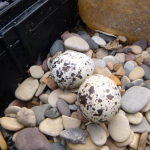 The record setting snowmelt in Barrow this spring has resulted in the earliest breeding season for the Black Guillemots on Cooper Island in the 42 years the colony has been studied. Median date of egg laying (when 50 percent of the nests have eggs) was June 16th. Three days earlier than the previous record – set in 2015. Early breeding is important this summer as birds may be able to have their young fledge before the major loss of sea ice predicted for August.
The record setting snowmelt in Barrow this spring has resulted in the earliest breeding season for the Black Guillemots on Cooper Island in the 42 years the colony has been studied. Median date of egg laying (when 50 percent of the nests have eggs) was June 16th. Three days earlier than the previous record – set in 2015. Early breeding is important this summer as birds may be able to have their young fledge before the major loss of sea ice predicted for August. - Guillemot Early Breeding Season and New Cooper Island PublicationsFieldwork at the Black Guillemot colony on Cooper Island began in early June, where I began the fifth decade of research on a remote island in a rapidly changing Arctic. Just how rapidly that change is occurring was obvious on the first day in the field, June 11, 2015, when I discovered that egg laying had already begun, with the first egg laid some two weeks earlier than the average date of the first egg over the last four decades. The early laying was a direct result of an extremely early snowmelt in Arctic Alaska that provided Black Guillemots access…
- Current Sea Ice StatusThe Black Guillemots on Cooper Island have seen their nesting success reduced over the past four decades as sea ice decline has reduced the availability of their preferred prey. Sea ice extent in the Arctic on June 15, 2015 was 9.1 (only one decimal point) million km sq., 10 percent less than the average for that date for 1979-2008. The above images show the proximity of sea ice to Cooper Island currently and for the same week in 2006. For maps from earlier in the summer see the ice information from National Ice Center.
- Cooper Island Guillemots and Shell’s Chukchi Sea Drilling PlansThe two weeks before I head north to Cooper Island are always an interesting mix of anticipation of the upcoming three-month field season combined with regret at having to leave my family and friends in Seattle. In recent years, as the Arctic continues to warm, there is a good amount of uncertainty as to what the next field season might bring. While the Nanuk cases now protect the Black Guillemots eggs and nestlings from polar bears forced to Cooper Island because of the melting sea ice, the increasingly frequent decreases in prey availability as the pack ice recedes and seawater…
- Polar bears almost get a guillemot this past summerA polar bear mother and nearly grown young almost get a brooding guillemot. The parent bird survived and was back on the nest the next day.
- The Black Guillemot
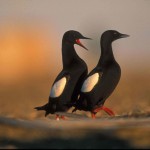 The Black Guillemot has a number of life history characteristics that make it an ideal monitor of changes in the marine environment in general and the Arctic in particular. Guillemots, of which there are three species, belong to the seabird family known as auks, or alcids. The most abundant seabird family in the Northern Hemisphere, the alcid family includes murres, puffins, auklets and murrelets. All members of the family dive to obtain prey below the sea surface typically in offshore pelagic waters some distance from land. Guillemots, however, are frequently associated with nearshore waters for most of the year, where…
The Black Guillemot has a number of life history characteristics that make it an ideal monitor of changes in the marine environment in general and the Arctic in particular. Guillemots, of which there are three species, belong to the seabird family known as auks, or alcids. The most abundant seabird family in the Northern Hemisphere, the alcid family includes murres, puffins, auklets and murrelets. All members of the family dive to obtain prey below the sea surface typically in offshore pelagic waters some distance from land. Guillemots, however, are frequently associated with nearshore waters for most of the year, where… - Annual Update on March 27th, 2014 at the Burke Museum in SeattleYou are invited to Friends of Cooper Island’s annual update and fundraiser on Thursday, March 27th at the Burke Museum on the Univ. of Washington campus. Doors open at 6 pm for socializing with beverages and appetizers with a presentation beginning at 7 pm. The evening will include stories and images from our exciting 3-month 2013 field season, which produced an unprecedented quantity of data and insights. We will also talk about how the increasing pace of warming and development in the Arctic is affecting the birds and the bears on the island, and what Friends of Cooper Island is…
- The chicks have arrived on Cooper Island!The first Black Guillemot chicks are hatching in the colony this week and they are just as cute as they are fluffy. There are currently 114 nests with parent birds sitting on eggs or brooding chicks which is making this a productive nesting season and gives us a lot to do each day as we monitor the population. I arrived on the island on July 15th and am up early each day, excited to open nest boxes and discover the newly hatched Black Guillemot chicks. It is a busy time for George and I am trying to help by recording…
- Seattle science teacher returns from Cooper IslandKatie with nest box. By Katie Morrison Heading back to Barrow, we glide across the glassy Elson Lagoon and it is hard to imagine the wind-driven angry whitecaps that filled the lagoon just a few days before. But tonight it is calm and still and we travel with ease in our open skiff. I am glad to be wearing the precautionary orange survival suit, for though it is a lovely evening, it feels quite cold to me. It’s after ten o’clock at night, the sky is filled with shades of orange and pinks and purples, and the midnight sun seems…
- Guillemots Go to the End of the Earth in Pursuit of Retreating Sea IceThe annual announcement of the minimum extent of the Arctic’s summer sea ice has become one of the more important metrics by which we measure the rate of change of our warming world. This year’s minimum extent of 3.4 million square kilometers (1.32 million square miles) on September 16th broke the previous minimum set in 2007 and was half of the average minimum for 1979-2000. This 3.5 million square kilometer loss in ice extent in the last twelve years is equal to an area two times the size of the State of Alaska. After my three months on Cooper Island…
- Black Guillemots mingle before getting down to businessCOOPER ISLAND, ALASKA — While no year on Cooper Island is like any other, so far the 2012 field season has been more different than most. For that reason ( and also because Max Czapankskiy did such a good job with his blogposts in June) I am way behind in my postings. In late June I took a rare break from my fieldwork to attend the Aspen Environment Forum where I was interviewed on Talk of the Nation, and early July has kept me busy monitoring guillemot egg laying that was delayed and disrupted by falcons and fox. I will be describing those…
- Learning to speak birdPosted by Max Czapansky: Ex-Microsoft employee wants to be a field biologist. Will he after his first season on Cooper Island? COOPER ISLAND, ALASKA — The birds arrived on Tuesday, I’m writing this on Friday, and during the interval George and I have been walking the colony, taking a census of the guillemots. Which birds have returned? Where are they nesting? With whom are they pairing? We record these data points in our field notebooks, and then later compile them in the breeding bird books for 2012. Even having done this for three days, I still worry that everything in my notes is…
- Inspiration and the midnight sunBARROW, ALASKA — Well, it is midnight and even though I promised myself to go to bed earlier, I am not able to withstand the draw of the midnight sun. One more walk down to the pack ice to look for another group of Common Eiders, one more discussion about changing ocean salinity, one more look at bright blue skies and sunshine. How can I not? I have really enjoyed the science talks at this workshop, from tracking bowhead whale populations, to using marine radars to follow ice moving offshore, to ocean ecosystems and their biological processes. In each Arctic…
- Special delivery for the birdsDuring the salad days of the Cooper Island Black Guillemot colony, in the late 1980s, there were 200 wooden nest sites, which I had created in the late 1970s with wood left on the island by the Navy two decades earlier. All 200 nests were occupied by breeding pairs and the colony enjoyed high breeding success — in large part due to the close proximity of sea ice and Arctic Cod, the guillemot’s preferred prey. During that time of “no vacancy” status and high prey availability, the colony regularly had over 150 guillemot young fledge in a single year. Two…
- Exit, pursued by a bearSEATTLE, WASHINGTON — For the last decade the end of my field seasons on Cooper Island could be summarized by what is considered Shakespeare’s most famous stage direction, “Exit, pursued by a bear”. It all started in 2002, when the North Slope Borough Search and Rescue helicopter had to pluck us off the island early one morning after we spent a long night taking a short-course in polar bear deterrence. More recent retreats from the island have been less dramatic but no less emotional. In 2008-2010 we maintained our daily measuring of guillemot nestlings while polar bears reduced their numbers nightly, breaking…
- In the beginningCOOPER ISLAND, ALASKA — While it seems like I have been at the Cooper Island black guillemot colony forever, there was actually a time when I did not spend the summer in Arctic Alaska wearing long underwear and worrying about polar bears for three months. George E. Watson, who was then a curator of birds at the Smithsonian Institution, played a pivotal role in getting me to the Alaskan Arctic in 1970, and to my finding the Cooper Island black guillemot colony in 1972. Last week George turned 80 years old and (while at this point of the summer it feels…
- Black Guillemots show their individuality with reactions to new nest boxesCOOPER ISLAND, ALASKA — I had no idea when I decided to provide 150 Nanuk plastic cases to protect the Cooper Island black guillemots how much the new nest sites would change the 2011 field season for both the birds and me. It was clear that I would need to arrive at the colony earlier than usual so that Penelope Chilton and I could dismantle the traditional wooden sites that were remnants from a 1950’s Navy camp and replace them with the new nest cases. Black guillemots at the nest sites originally built by George out of World War II Navy debris. What…
- A visit to Cooper IslandPost and photos by guest blogger, Greg O’Corry-Crowe COOPER ISLAND, ALASKA — Mid July and I finally get the opportunity to visit Cooper Island and its birds and to work with George Divoky. Over the years George and I had discussed ways to collaborate. If we could only put his unique four-decade long study of black guillemots and their environment together with investigations of their DNA, we could fill in some key gaps in this unique study of a seabird against a backdrop of dramatic environmental change. These discussions ramped up into real plans last fall and now I was speeding across Elson lagoon towards…
- Solitary scientist at the top of the worldCOOPER ISLAND, ALASKA — The subtitle of Darcy Frey’s 2002 NY Times Magazine article on the early impacts of climate change seen on Cooper Island, referred to me as a “lonely scientist at the end of the earth”. This wording was likely the work of an editor, who wanted to portray the “forlorn” qualities inherent in the word “lonely” and the phrase “end of the earth”. A more accurate (but less romantic) wording would be a “solitary scientist at the top of the world”. While it is true that I have spent weeks and months alone on the island without company, it is…
- Holiday greetingsCOOPER ISLAND, ALASKA — Celebrating a solitary Independence Day on Cooper Island with a few hundred black guillemots. While many guillemots are still laying eggs, yesterday I saw the first successful fledge of the year — a barely flying snow bunting that was still being fed by a parent. Snow bunting nests can produce up to seven chicks and feeding and tracking that many flying (or at least fluttering) young is a major job for the parents. Snow bunting nest The big news from this past weekend was the movement of the shorefast ice (ice that is frozen to the beach and nearshore shallows during the winter) as…
- George and the guillemots get used to their new homesCOOPER ISLAND, ALASKA — While the start of every field season is always an exciting (and frequently stressful) time, this year the start of the Cooper Island field season had more excitement than most. Preparations began earlier than normal as March and April involved acquiring, modifying and transporting 150 Nanuk plastic cases to replace the wooden nest boxes that allowed guillemots to breed successfully for almost four decades, but which in recent years have been destroyed by polar bears as they prey on guillemot nestlings. The cabin acts as a windbreak so snow in this area melts slower than on…
- Sponsor a bear-proof nest sitePosted by Lori Two Black Guillemots with its distinctive red mouth lining and feet. Here’s your chance to get involved in the work being done on Cooper Island: Friends of Cooper Island is initiating a “Nest-Site Sponsorship” program to help pay for nest replacement and our ongoing research on Arctic seabirds. A minimum $100 tax-deductible donation will sponsor a nest site for one year and bring you (or an individual or school group you designate) updates about the fieldwork and observations on the island, the history of the breeding birds using the sponsored site and additional site-specific information. At the…
- Video: Forty years of work in five minutesGeorge is back from Cooper Island (for now) after having delivered 150 plastic cases to the island for use as new guillemot nest sites. (More information about these cases and how you can sponsor a nest site coming soon.) George will be returning to Cooper Island in May and will stay for 3 months to study the affects of climate change on the black guillemot. This video explains George’s work and what it has been like living among birds and bears on Cooper Island for 3 months of every year for the last 35 plus years.
- Getting ready for the seasonPosted by Lori George has left for Cooper Island on a short trip to get ready for the season that will begin in May. He’s a little swamped right now, so I’ll be posting updates to kick things off. George left his home in Seattle for Barrow, Alaska, the first stop on the way to Cooper Island. With him he took 150 plastic cases which, if things work out the way George is hoping, will save the Arctic black guillemot. It seems because of the melting ice pack polars are coming to Cooper Island to find food, which happens to…
- Pelican Cases: Hope for Cooper Island’s Arctic SeabirdsCooper Island, Alaska, Sept. 7, 2010 — The increasing distance between Cooper Island and the August pack ice has resulted in a range of problems for the black guillemots breeding on the island. The decreased access to their preferred prey of Arctic cod, which live under sea ice and in the cold waters adjacent to the ice, has caused decreased production of young. The northward range expansion of the horned puffin, partially in response to the retreat of summer pack ice, has greatly reduced guillemot nestling survival as puffins kill (but do not eat) the young of the guillemots during nest…
- Survival in a New ArcticCooper Island, Alaska, Aug. 18, 2010 — The transitions in the summer season on Cooper Island tend to be step changes rather than gradual trends for both me and the Black Guillemots I am studying. This reflects, in part, the rapid shifts that occur in the Arctic when it goes from “winter” to “summer” in a matter of days as the snow melts from the island and then, about a month later, when the nearshore waters go from ice-covered to open water with one good windstorm. The breeding season for the Black Guillemots, which has three distinct periods, is marked…
- The Gulf Oil spill and Cooper Island seabirds – so far and yet so nearCooper Island, Alaska, July 31, 2010 — Cooper Island is about as far from the Gulf of Mexico, and its now-oiled waters, as one can be and still be in the United States. But the Deepwater Horizon blowout, and the resulting paradigm shift in how the government and public views offshore oil drilling, will have a major effect on the potential threats of oil to the arctic marine system that surrounds this island. Cooper Island biota has a history of being affected by distant and political forces: The boxes and debris used by nesting Black Guillemots are only here because…
- A Very Common Species Provides a Very Big SurpriseCooper Island, Alaska, July 27, 2010 — When my interest in bird-watching first developed in the 1960s (the avocation would not be called “birding” for a number of years), a common wintertime activity was visiting the Cleveland lakefront and scanning the flocks of gulls for any interesting vagrants among the large number of Herring Gulls that wintered on the south shore of Lake Erie. One of our “fantasy birds” was the Glaucous Gull. The thought that this large and very pale arctic species might visit our temperate latitudes was very exciting and a sighting would provide a link to remote…
- Extraordinary Rain Delays Survey of IslandCooper Island, Alaska, July 21, 2010 — In addition to documenting the timing and success of the Black Guillemots breeding on Cooper Island I always make an assessment of the other avifauna attempting to raise their young here. The changes that have occurred in some of those populations have been almost as striking as the findings for Black Guillemots. Brant, a coastal goose, formed a major colony in the past two decades while Arctic Terns went from being the most abundant species on the island three decades ago to having just a few scattered pairs today. An Arctic Tern takes…
- Waiting for the PuffinsCooper Island, Alaska, July 12, 2010 — As Black Guillemots finished up their egg laying — the last of the nests got eggs this weekend — I had the pleasure of having two visitors from the BBC’s Natural History Unit. Anyone with an interest in nature has seen some or all of the BBC’s excellent “Planet Earth” series, which does indeed live up to its catchphrase “Earth as you’ve never seen it”. The BBC is now wrapping up filming for a series entitled “Frozen Planet” with the catchphrase “Earth as you’ll never see it again”. They have been filming frozen…
- Birds, Bears and the BBCCooper Island, Alaska, July 8, 2010 — This post, like the start of summer on the North Slope is a bit tardy. Once Black Guillemot egg laying finally started in the last week of June, I was busy checking every one of the 200 nest sites on the island to determine date of egg laying. The snow drift in front of my cabin persisted until the Fourth of July due to both the large amount of winter snow accumulation and the cool temperatures in May and June. Snowmelt in front of the guillemot nest sites was also slow. Black Guillemot…
- April in Barrow – making sure the cabin (and the Arctic) survived the winterSeattle, Wash., May 4, 2010 — Over the last four decades there have been many technological advances that have helped make the fieldwork on Cooper Island more pleasant and efficient but none has had a bigger impact on day-to-day operations than the addition of the 8×12 ft. cabin that has served as a summer home since 2003. After the 2002 field season it was clear to me (and to my field companions who saw their tents shredded by a polar bear in August 2002) that there was a need for sturdier living quarters on Cooper Island. While protection from bears…
- It Takes a Colony to Raise one YoungCooper Island, Alaska, Aug. 27, 2009 — What seems like a long,long time ago,black guillemots on Cooper Island had the best of all possible worlds. The summer snow-free period was increasing annually, providing breeding birds with more time to raise their young, and the Arctic pack ice was close enough offshore that there was a readily accessible supply of Arctic cod to feed the nestlings. The only real dark cloud on the horizon was the realization, slow in coming over the past three decades, that the warming planet that had given the guillemots their “salad days” in the 1970s and…
- Back to CivilizationCooper Island, Alaska, Aug. 22, 2009 — Last Monday evening near the end of a rainy stormy day, I called Lewis Brower, who would be my transportation to Barrow, to let him know that I hoped to see him on Wednesday when winds were predicted to be close to 10 mph. All day Monday wind speeds had been in the high teens and low 20s and from a direction that meant waves were breaking on both sides of the island. To my surprise Lewis told me he was getting his boat ready and would be on his way from Barrow…
- Is It a Bird or a Bear?Cooper Island, Alaska, Aug. 14, 2009 — This summer I find myself looking at images obtained over the past month on Cooper Island and thinking “what is wrong with these pictures?” But I know that the images of polar bears walking around the colony, sleeping on the beach and approaching the campsite, things I could never have imagined before 2002, are the product of habitat degradation rather than any image manipulation. Because of the frequency and type of bear encounters in August 2008, I was looking for some way to have an alarm that would let me know a bear…
- Don’t Count Your Chickens Before They’re FledgedCooper Island, Alaska, Aug. 12, 2009 — Of all the questions people ask me about guillemots, one of the least common is “What the heck does ‘guillemot’ mean?”. This surprises me, since I would think that would be one of the first things people would wonder about the bird. It turns out that “guillemot” is the diminutive of Guillaume – the French version of “William”. But it also turns out that no one seems to know why the genus Cepphus — or in England the closely related members of the genus Uria — are called guillemots. When talking to school…
- Driftwood: Sign of a Changing ArcticCooper Island, Alaska, Aug. 9, 2009 — Driftwood lines in the middle of Cooper Island are important for nesting terns and waterfowl, but in any given year there typically has been little accumulation of wood on the island’s beaches. Until recently, the short duration and limited amount of ice-free water were not conducive to movement and deposition of driftwood. Hundreds of miles north of the tree line, driftwood on Cooper Island apparently comes primarily from the Mackenzie River. When the Beaufort Sea had limited open water, wood coming out of the Mackenzie would likely have had little chance to drift…
- August SurpriseCooper Island, Alaska, Aug. 4, 2009 — The National Weather Service has been saying that the main pack ice is over 100 miles away — and that is apparently true — but this aggregations of very small floes and ice chunks showed up north of Cooper late on Sunday. It persisted through Monday — when the above picture was taken — and guillemots could be seen diving next to the floes and returning arctic cod to their young. The ice charts show this to be the only ice for this area of coast and its appearance off Cooper was fortuitous…
- The Edge of CivilizationCooper Island, Alaska, Aug. 6, 2009 — Cooper Island is only 25 miles (as the guillemot flies) from the community of Barrow, the largest village on the Alaska’s North Slope. When the atmospherics are right one can see the inverted mirage of Barrow shimmering on the northwest horizon, and on calm days there is a low hum as the village’s generators, fueled by a small natural gas field a few miles out of town, provide power to the 4500 residents. These reminders that there is a town just over the horizon make me aware that my field camp is in…
- Pink Feces – A Sign of Climate Change or Adaption?Cooper Island, Alaska, Aug. 2, 2009 — My focus on the birds breeding (or trying to breed) on Cooper Island runs the risk of making it seem like the island and surrounding waters are important to a relatively limited avifauna. In reality, the island is on one of the major migratory pathways for birds breeding on the tundra of Alaska’s North Slope and the western Canadian Arctic. In July and August, after breeding is complete, large numbers of waterfowl, shorebirds and seabirds move to the near shore Beaufort Sea and then westward to Point Barrow before heading south through the…
- Polar Bear Update IICooper Island, Alaska, Aug. 3, 2009 — I was writing up the text for the “krill” last night and then there was a need to deal with a bear that had been sleeping on the north beach after coming in off the ocean. Clearly the cabin is the best (or worst) smelling thing on the island and bears always seem to head for camp after they wake up. I had to turn the bear around and then wait for it to walk off to the east before going to sleep. I turned the bear around with a “cracker shell” that…
- Polar Bear UpdateCooper Island, Alaska, July 29, 2009 — Record high of 70 degrees F. (23 degrees F. above normal) in Barrow yesterday which tied the previous record high. The temperature on Cooper Island was 66 degrees F and I would have enjoyed the warmer air more if there was not a bear trying to cool down in grass clumps in the tern colony (0.5 to 0.75 miles from camp, but very visible). At one point the bear dug a hole in a grassy dune and slept for awhile — which would have been more cooling if the permafrost was still here….
- When Habitats CollideCooper Island, Alaska, July 27, 2009 — In the late 1970s during the first field seasons on Cooper Island, my colleagues and I were preoccupied with the possibility of encountering polar bears since we were sleeping in a tent 20 yards from the Arctic pack ice, the primary habitat of polar bears. We assumed we would see bears with some regularity. But it turns out we didn’t see any bears in the first five summers on the island. The lack of sightings was due to being “adjacent” to polar bear habitat, but not “in” polar bear habitat. As is clear…
- True LoveCooper Island, Alaska, July 22, 2009 — Black guillemots, like all seabirds, need both parents to incubate eggs and care for young. This mutual participation of males and females in raising young means the breeding success for an individual guillemot depends to a great extent on finding and maintaining a bond with a high quality mate that will share and excel in raising young to fledging. The cooperation of both parents might be most critical during the current stage of breeding, when chicks are hatching and parents are transitioning from providing nearly continuous warmth (for the egg and young downy…
- FootprintsCooper Island, Alaska, July 19, 2009 — It is not uncommon to hear a hiker or wilderness camper describe the exceptional nature of an outing by emphasizing that at some point on their excursion they realized they might be the first human to ever step foot at that spot. In my opinion, this statement, places too much importance on the individual, in settings which ideally should provide recognition of exceptional nature of an outing by the relative unimportance of oneself compared to the natural world, but it does reflect the common view that people like their wilderness experiences to be…
- A Little HistoryCooper Island, Alaska, July 9, 2009 — This year, an ambitious “Around the Americas” expedition will attempt to have their sailboat, Ocean Watch, negotiate the Northwest Passage as part of their program to conduct research and also raise public awareness of the state of the oceans. They departed Seattle in early June and will circumnavigate both North and South America in 13 months. Ocean Watch is leaving Nome this week, and will be in Barrow on July 11. You can follow their progress at their website at http://aroundtheamericas.org. They plan on visiting Cooper Island on their way east through the…
- The Unpredictability of IceCooper Island, Alaska, July 8, 2009 — Henry David Thoreau wrote that “Ice is a fit subject for contemplation” as he monitored the formation and melt of ice on Walden Pond in the mid 19th century. He had no idea how important monitoring, studying and contemplating Arctic sea ice would become in the late 20th and early 21st century, as the increasing annual retreat of the ice became one of the more dramatic and disturbing signs of changes in global climate. When I first began my work on Cooper Island in the mid-1970s the near shore waters north of the…
- On Cooper IslandCooper Island, Alaska, July 7, 2009 — I arrived at my field camp on June 15 having chartered a helicopter from Barrow, Alaska, 25 miles west of Cooper Island. The days just before the field season started were full of the typical mixture of excitement for the opportunity to return to this remote Arctic island coupled with the apprehension that comes from knowing that if some critical piece of equipment is left behind one would have to get by for weeks before resupply is possible. This year a critical piece of communications equipment needed to be repaired, which is the…
- Depending on Wind and SunCooper Island, Alaska, July 25, 2009 — People frequently mention to me that summer in the Arctic must be really exhilarating because of the “24 hours of daylight”. While this is true, less well known is that the “24 hours of wind” can make living at this latitude somewhat of a chore, no matter how much daylight one experiences. On Alaska’s arctic coast a rather constant wind blows from the northeast during almost all months, maintained by a high pressure system sitting over the Beaufort Sea. This summer has seen winds of strength and duration that are surprising even to…
- Married to the ArcticCooper Island, Alaska, July 12, 2009 — Many bird species are thought to be “Arctic birds” because they migrate to the Arctic every spring, utilize the region’s resources for breeding, and then depart for more southern wintering areas in late summer and early fall, spending the majority of the year well south of the Arctic Circle. These species have a “summer romance” with the Arctic, enjoying the benefits of constant daylight and the abundant food resources provided by the region’s insect and fish populations. A much smaller number of bird species are truly “married” to the Arctic, remaining after breeding…
- Getting Ready for Life on the EdgeSeattle, Wash., June 10, 2009 — After over three decades of conducting summer fieldwork on seabirds in Arctic Alaska one would think that pre-field preparations would be a matter of habit and that that the level of anticipation and anxiety associated with heading off to a remote island would be minimal. But as I prepare to spend three months living at the edge of the continent and pack ice studying black guillemots on Cooper Island, I am reminded of the philosophical observation that no man can step in the same river twice. Anyone who has spent time in the Arctic…
- Preparing for the 2009 Field SeasonSeattle, Wash., June 1, 2009 — In 2008 fledging success of black guillemots was again low. Unlike past years, when chicks died as a result of prospecting horned puffins occupying nest sites and a lack of Arctic cod, in 2008 chicks had to deal with snow storms blocking nest entrances and stranded polar bears flipping over nests as they scavenged the beaches for food. The 2009 field season promises to be another interesting one as the melt season begins with the Arctic Basin having a large percentage of of thin first-year ice, according to the National Snow and Ice Data…
